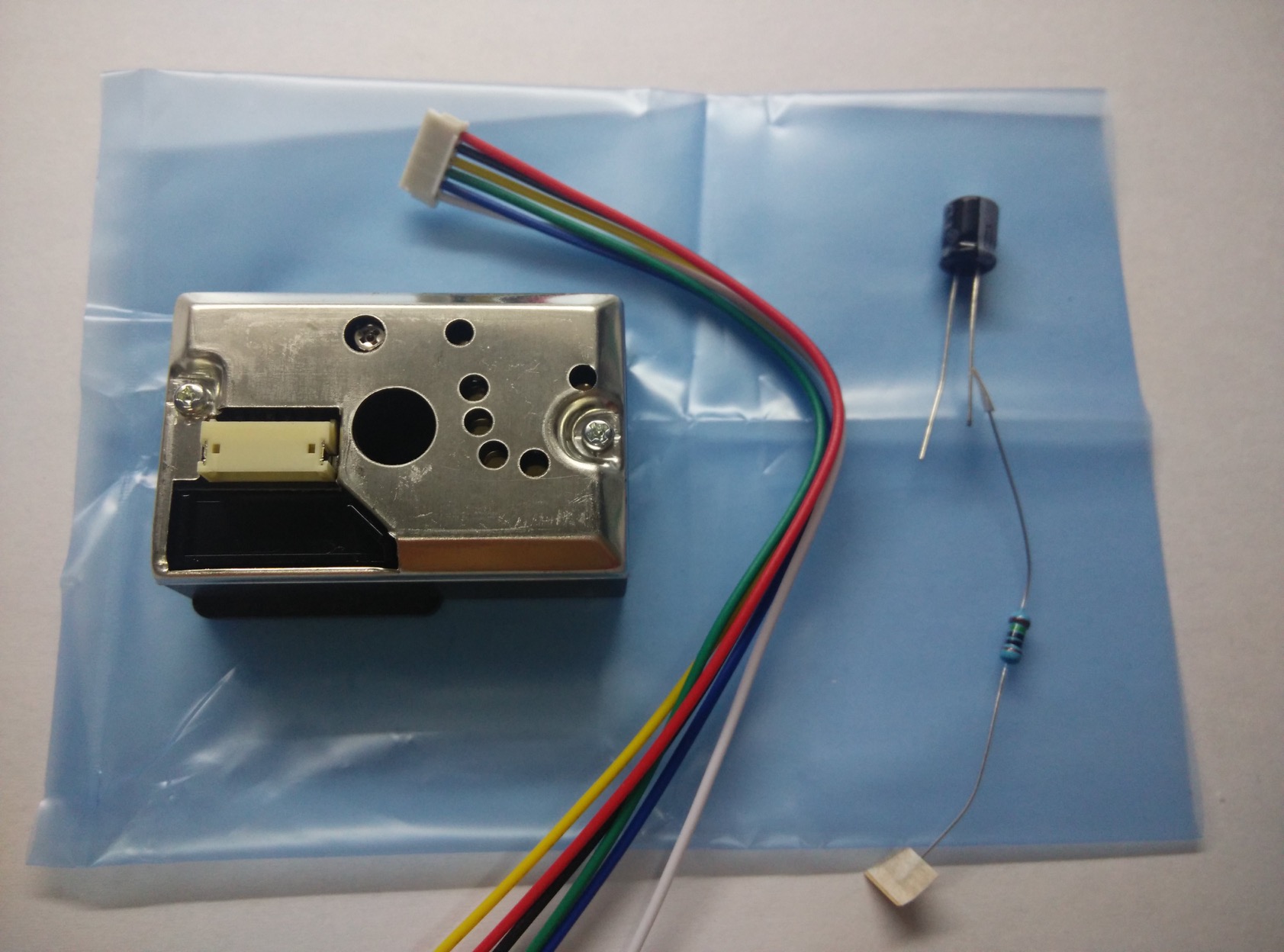As part of my ambition to monitor the home ambience, I’d like to quantify “air pollution”. As usual, I’m not willing to shell out for than a few dozen bucks for a dust sensor. There are several cheap particulate matter detector (commonly known as dust sensor) that’s available in the market, such as the Shinyei PPD42 and Sharp GP2Y1010AU0F. These sensors uses the light (in this case, Infrared) scattering method to detect concentration of fine particles.
I came across the writing which generally concludes that the Sharp is more stable. Besides, I think the Sharp has better shape and form factor. Hence, I bought few units of the Sharp, which focuses on PM2.5 particles (as opposed to the Shinyei which reads PM10 as well).
The 6-pin connectors, capacitor and resistor came together (if not provided, do buy them to save yourself some trouble). I added the pin headers at the other end for ease of use with the breadboard.
I followed the guide at Arduino website, with a little modification to the code (i.e. 3.3v instead of 5v) so that it works with my ESP8266. At first glance, it seems good as I get some values in the range of 20-50mg/m3 which is acceptable (although a little high, considering that my windows are close most of the time) for an apartment in the Klang Valley. Putting a pen/wire into the hole immediately give the maximum reading of around 230mg/m3.
I’ve also designed and 3D-printed an enclosure for this “sensor node”. If you’re interested, you can get the STL on Thingiverse. Note that I had to provision additional space on the side for the pin headers.
When the second unit is powered up, putting them side by side often gave reading that differs by around 20-50%. I was caught by surprise as at this accuracy, it’s not really possible to compare air quality between different locations. Thinking that I may have a faulty or mis-calibrated unit, I purchased another few units.
Now, I decided to place them together, using the Arduino since it has multiple analog in ports, and 5v as recommended by Sharp in the datasheet/application note. I use the Ethernet shield, to publish all the readings to the database.
Surprise… the result doesn’t seems to be much better. The visualisation with Grafana below shows the readings obtained from 3 identical sensors over the period of 7 days (since I put them together). The sensors are placed on top of the TV cabinet in the living room.
As seen above, the reading seems to be erratic. Sometimes I did not make any change but can see significant change in the reading obtained. Besides, the absolute value obtained between the sensors differs a lot. Honestly, I have no idea what’s the cause and how this can be solved. Calibrating these sensors in a non-laboratory environment will also be challenging, and maybe not so feasible. As for now I’ll just accept it.
Conclusion, this Sharp sensor can be used as an indicator if the air is clean or polluted. It is however not possible to compare with official PM2.5 readings. It’s also not possible to compare the values between identical sensor. This is probably true for all the cheap (i.e. hobbyist) dust sensor using the IR light scattering technique.
I look forward to hearing about your experience on monitoring pollution using low cost sensor such as this.






Hi, can you confirm that you use ESP8266 to control the sensor ?
As i know the sensor out is a analog signal from 0 to 5V, and esp8266 ADC input just read from 0 to 1.
How have you arrange with this ?
Thanks
Francesco, italy
Hello Francesco,
I can confirm working with this sensor with the ESP8266. The supply voltage to the sensor must be 5v (not an issue since I’m powering the NodeMCU from USB). The analog output of the sensor will indeed be 0-5v, however I’m not using the sensor in dusty area so the reading will not exceed 3.3v.
By the way, I highly recommend the use of laser based sensor instead. Such as the Plantower PMS5003 which I’ve been running for many months now. It’s worth the money. I’ve tossed the Sharp GP2Y1010AU0F aside due to it’s horrendous accuracy.
Regards,
Calvin
Great job….. Calvin….
I teach environmental sciences course to undergrad students here in India; thought of doing a project with them. I too found quite erratic values for the Sharp sensor I bought. In fact, all my values are fractional ones (below 1). Dont know how to move ahead. Could you suggest me few other sensors (the laser based). I got this problem of procuring them in India.
Hi Ahmed, apologies for the late reply. I’d suggest the Plantower 5003 (or around that range). It’s not too costly (I got it shipped from China to my apartment in Malaysia for about USD25 all in). It’s pretty precise, putting 2 of them side by side and it doesn’t vary more than few %.